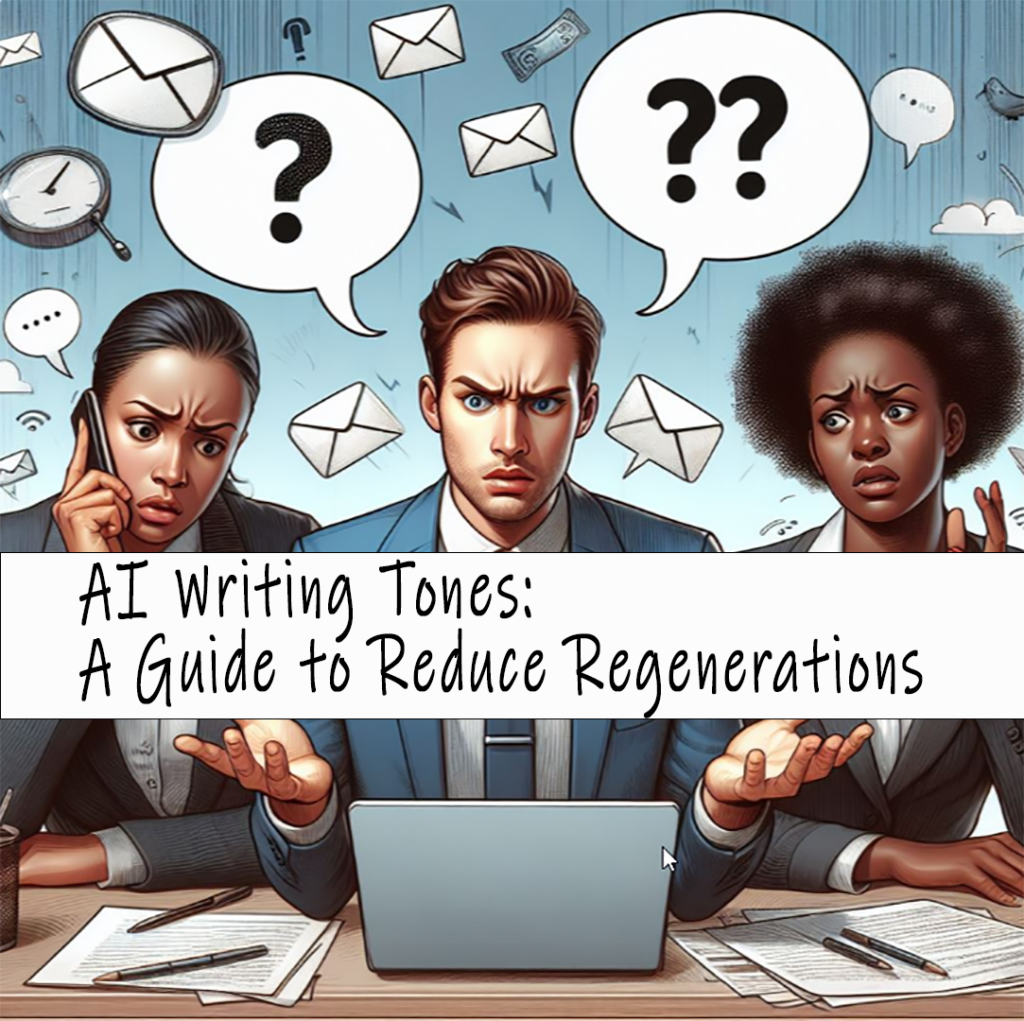Don’t be misunderstood by AI Assistant Tools like Microsoft Copilot, ChatGPT, or Google Gemini
Understanding Writing Tone
Writing tone is the way you express your attitude, mood, and personality through words. Your choice of tone can influence how your readers perceive your message, trust you, and respond to your call to action. The beauty of writing tone is its adaptability to different contexts, audiences, and purposes. This knowledge empowers you to select the perfect tone for every situation, giving you the confidence that your message will be received as intended.
Using AI Assistants to Perfect Writing Tone
In a world where AI Assistants like ChatGPT, Microsoft Copilot, and Google Gemini are becoming more prevalent, users often guide these AI agents to deliver a successful first draft. It is your Smart to Start tool. You must describe what you want from these bots to reduce the number of regenerations. In other words, they don’t have feelings, moods, or personalities. It is up to you to direct your messaging by incorporating one of the main ingredients – Writing Tone.
Comprehensive List of Writing Tones
This blog post is designed to be your practical companion, providing a comprehensive list of 50 writing tones with concise descriptions. We’ll also share straightforward suggestions for applying these tones in various scenarios. Drawing examples from Grammarly.com and other writing assistance applications, we’ll demonstrate how writing tone can enhance your content and business communications.
- Aggressive: Uses strong and forceful language, expresses anger and hostility, and avoids compromise or concession.
- Ambitious: Uses aspirational and optimistic language, expresses confidence and determination, and avoids doubt or hesitation.
- Amusing: Uses humorous and witty language, expresses fun and lightheartedness, and avoids seriousness or boredom.
- Analytical: Uses logical and rational language, expresses facts and evidence, and avoids emotions or opinions.
- Appreciative: Uses grateful and respectful language, expresses recognition and praise, and avoids criticism or complaints.
- Assertive: Uses confident and direct language, expresses opinions and needs, and avoids passivity or aggression.
- Authoritative: Uses credible and expert language, expresses knowledge and leadership, and avoids uncertainty or weakness.
- Bold: Uses daring and adventurous language, expresses courage and risk-taking, and avoids caution or fear.
- Casual: Uses informal and relaxed language, expresses familiarity and friendliness, and avoids formality or stiffness.
- Cheerful: Uses positive and upbeat language, expresses happiness and enthusiasm, and avoids negativity or gloom.
- Collaborative: Uses cooperative and inclusive language, expresses teamwork and partnership, and avoids competition or conflict.
- Colloquial: Uses slang and idiomatic language, expresses authenticity and culture, and avoids standard or academic language.
- Compassionate: Uses empathetic and caring language, expresses support and sympathy, and avoids> indifference or judgment.
- Confident: Uses self-assured and decisive language, expresses belief and certainty, and avoids doubt or insecurity.
- Conversational: Uses natural and engaging language, expresses interest and curiosity, and avoids monotony or detachment.
- Creative: Uses imaginative and original language, expresses innovation and novelty, and avoids clichés or conventions.
- Critical: Uses evaluative and judgmental language, expresses feedback and improvement, and avoids praise or acceptance.
- Curious: Uses inquisitive and exploratory language, expresses learning and discovery, and avoids ignorance or assumption.
- Diplomatic: Uses tactful and respectful language, expresses compromise and consensus, and avoids controversy or offense.
- Direct: Uses clear and concise language, expresses facts and actions, and avoids ambiguity or vagueness.
- Educational: Uses instructive and informative language, expresses teaching and learning, and avoids confusion or misinformation.
- Elegant: Uses refined and sophisticated language, expresses grace and style, and avoids vulgarity or clumsiness.
- Emotional: Uses expressive and passionate language, expresses feelings and sentiments, and avoids rationality or objectivity.
- Empowering: Uses motivational and inspirational language, expresses encouragement and empowerment, and avoids discouragement or dependence.
- Entertaining: Uses captivating and enjoyable language, expresses amusement and delight, and avoids boredom or displeasure.
- Formal: Uses professional and polite language, expresses respect and courtesy, and avoids casual or colloquial language.
- Friendly: Uses warm and pleasant language, expresses kindness and rapport, and avoids hostility or coldness.
- Funny: Uses comical and amusing language, expresses humor and laughter, and avoids seriousness or dullness.
- Honest: Uses truthful and sincere language, expresses integrity and candor, and avoids deception or exaggeration.
- Humble: Uses modest and unassuming language, expresses humility and gratitude, and avoids arrogance or boastfulness.
- Informal: Uses casual and relaxed language, expresses familiarity and friendliness, and avoids formality or stiffness.
- Inspirational: Uses motivational and uplifting language, expresses vision and purpose, and avoids pessimism or apathy.
- Intimate: Uses personal and confidential language, expresses closeness and trust, and avoids distance or secrecy.
- Ironic: Uses sarcastic and paradoxical language, expresses contrast and contradiction, and avoids literal or straightforward language.
- Joyful: Uses positive and cheerful language, expresses happiness and enthusiasm, and avoids negativity or gloom.
- Neutral: Uses unbiased and objective language, expresses facts and information, and avoids opinions or emotions.
- Nostalgic: Uses sentimental and reminiscent language, expresses longing and memory, and avoids present or future tense.
- Persuasive: Uses convincing and influential language, expresses arguments and reasons, and avoids doubts or objections.
- Playful: Uses fun and lighthearted language, expresses enjoyment and creativity, and avoids seriousness or boredom.
- Polite: Uses respectful and courteous language, expresses manners and etiquette, and avoids rudeness or offense.
- Professional: Uses formal and appropriate language, expresses competence and reliability, and avoids casual or colloquial language.
- Provocative: Uses controversial and challenging language, expresses criticism and dissent, and avoids agreement or conformity.
- Romantic: Uses affectionate and passionate language, expresses love and attraction, and avoids indifference or detachment.
- Sarcastic: Uses ironic and mocking language, expresses humor and ridicule, and avoids sincerity or respect.
- Scholarly: Uses academic and research-based language, expresses knowledge and expertise, and avoids informal or unverified language.
- Simple: Uses plain and easy language, expresses clarity and brevity, and avoids complexity or verbosity.
- Sincere: Uses honest and heartfelt language, expresses authenticity and candor, and avoids deception or exaggeration.
- Skeptical: Uses doubtful and questioning language, expresses uncertainty and disbelief, and avoids credulity or acceptance.
- Stylish: Uses fashionable and trendy language, expresses flair and originality, and avoids dullness or commonness.
- Urgent: Uses pressing and immediate language, expresses importance and priority, and avoids delay or indifference.
Suggested Tones for Other Scenarios
Choosing the right tone for different situations is important. It provides valuable insights on how to use tone effectively, whether creating persuasive advertisements or establishing authority during product launches. Each scenario requires a distinct tone approach to achieve your goals and connect with your audience.
- Marketing Advertisements: Use persuasive, playful, bold, or provocative tones to catch your audience’s attention and convince them to buy your product or service.
- Product Announcements: Use tones such as informative, enthusiastic, creative, or authoritative to inform your audience about the features and benefits of your new product or service.
- Job Offers and Postings: Use professional, friendly, inviting, or empowering tones to attract qualified candidates and make them feel welcome and valued in your organization.
- Conference Invitations: Use educational, inspirational, collaborative, or amusing tones to entice your audience to attend your event and learn from your speakers and peers.
- For sales pitches: Use confident, assertive, analytical, or urgent tones to persuade potential customers to trust you and act on your offer.
Work Your Magic!
Remember, the proper writing tone can be the catalyst that propels your message to new heights of engagement. So, as you direct an AI agent to generate your next draft in Copilot, ChatGPT, or Gemini, be mindful of how you express yourself and how your audience perceives you by choosing the right tone. Happy writing!



